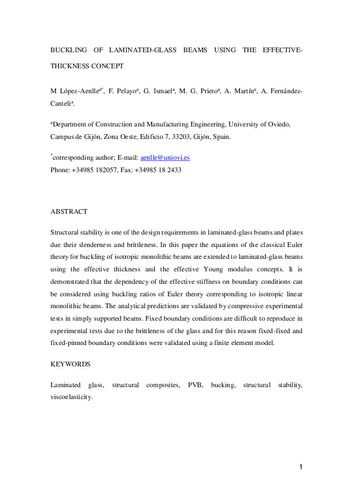Buckling of laminated-glass beams using the effective-thickness concept
Subject:
Laminated glass
Buckling
Viscoelasticity
Publication date:
Editorial:
Elsevier
Publisher version:
Citación:
Descripción física:
Abstract:
Structural stability is one of the design requirements in laminated-glass beams and plates due their slenderness and brittleness. In this paper the equations of the classical Euler theory for buckling of isotropic monolithic beams are extended to laminated-glass beams using the effective thickness and the effective Young modulus concepts. It is demonstrated that the dependency of the effective stiffness on boundary conditions can be considered using buckling ratios of Euler theory corresponding to isotropic linear monolithic beams. The analytical predictions are validated by compressive experimental tests in simply supported beams. Fixed boundary conditions are difficult to reproduce in experimental tests due to the brittleness of the glass and for this reason fixed–fixed and fixed–pinned boundary conditions were validated using a finite element model
Structural stability is one of the design requirements in laminated-glass beams and plates due their slenderness and brittleness. In this paper the equations of the classical Euler theory for buckling of isotropic monolithic beams are extended to laminated-glass beams using the effective thickness and the effective Young modulus concepts. It is demonstrated that the dependency of the effective stiffness on boundary conditions can be considered using buckling ratios of Euler theory corresponding to isotropic linear monolithic beams. The analytical predictions are validated by compressive experimental tests in simply supported beams. Fixed boundary conditions are difficult to reproduce in experimental tests due to the brittleness of the glass and for this reason fixed–fixed and fixed–pinned boundary conditions were validated using a finite element model
ISSN:
Patrocinado por:
The financing support given by the Spanish Ministry of Economy and Competitiveness through the project BIA2014-53774-R is gratefully appreciated
Collections
- Artículos [37556]
- Construcción e Ingeniería de Fabricación [508]
- Investigaciones y Documentos OpenAIRE [8424]
Files in this item




